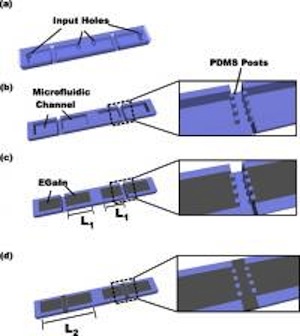Science Fiction
Dictionary
A B C D E F G H I J K L M N O P Q R S T U V W X Y Z
Shape-Changing Metal Antenna

Researchers at Utah and North Carolina have created a controllable metal antenna that can change its shape, and thus the frequency at which it resonates, on demand.

(Shape-Changing Metal Antenna)
To fabricate the antenna, the researchers injected a conductive, low-viscosity metal alloy (eutectic gallium indium, or EGaIn) into a 51-mm-long microchannel that is divided into four segments. Two rows of posts placed perpendicular to the channel divide the inner and outer segments of the antenna. A thin, membrane-like solid oxide skin spontaneously forms on the metal surface that mechanically stabilizes the metal at the posts, preventing metal in adjacent segments from merging. The liquid metal remains stable as long as its surface oxide is not ruptured.At a length of 25 mm, the initial dipole antenna state, defined by the two inner segments, represents the shortest of three possible states. As the shortest antenna, it also has the highest frequency. In order to elongate the antenna, and thus decrease its frequency, the researchers applied a critical pressure on the liquid metal at one segment boundary. This critical pressure ruptures the oxide skin and squirts the metal between the posts to merge with one of the outermost metal segments. This process increases the length of the antenna and creates a second state at a lower frequency than the first state. By controlling the spacing between the posts, the researchers could control the pressure at which the oxide ruptures.
To achieve the third state – the one with the longest length and lowest frequency – the researchers ruptured the skin on the other side of the antenna, allowing the liquid metal in the inner segment to merge with the other outer segment. Once the skin is ruptured, the metal flows extremely quickly – in a few milliseconds – due to its low viscosity and the short distance it has to travel.
In his 1942 novella Waldo, Heinlein draws on the idea of broadcast power. The aircars (including the amazing broomstick speedster) use standard, rigid antennas to draw power.
As the story progresses, the deKalb antennas mysteriously fail to function. When one of them is fixed by a "hex doctor", engineers go to investigate.
"What!" put in Stevens. "You don't mean to stand there and tell me an old witch doctor fixed your deKalbs.""Not witch doctor - hex doctor..."
The skycar looked quite ordinary. Stevens examined the deKalbs and saw some faint chalk marks on their metal sides... "Watch while I cut in reception."
Stevens waited, heard the faint hum as the circuits became activized and looked.
The antennae of the deKalbs, each a rigid pencil or metal, were bending, flexing, writhing like a cluster of worms. They were reaching out, like fingers...
(Read more about Heinlein's broadcast power receptors)
From Physorg.
Scroll down for more stories in the same category. (Story submitted 7/31/2011)
Follow this kind of news @Technovelgy.| Email | RSS | Blog It | Stumble | del.icio.us | Digg | Reddit |
Would
you like to contribute a story tip?
It's easy:
Get the URL of the story, and the related sf author, and add
it here.
Comment/Join discussion ( 0 )
Related News Stories - (" Engineering ")
Secret Kill Switch Found In Yutong Buses
'The car faltered as the external command came to brake...' - Keith Laumer, 1965.
The Desert Ship Sailed In Imagination
'Across the ancient sea floor a dozen tall, blue-sailed Martian sand ships floated, like blue smoke.' - Ray Bradbury, 1950.
The Zapata Air Scooter Would Be Great In A Science Fiction Story
'Betty's slapdash style.'
Could Crystal Batteries Generate Power For Centuries?
'Power could be compressed thus into an inch-square cube of what looked like blue-white ice' - Edmond Hamilton, 1940.
Technovelgy (that's tech-novel-gee!) is devoted to the creative science inventions and ideas of sf authors. Look for the Invention Category that interests you, the Glossary, the Invention Timeline, or see what's New.
Science Fiction
Timeline
1600-1899
1900-1939
1940's 1950's
1960's 1970's
1980's 1990's
2000's 2010's
Current News
Bone-Building Drug Evenity Approved
'Compounds devised by the biochemists for the rapid building of bone...'
Secret Kill Switch Found In Yutong Buses
'The car faltered as the external command came to brake...'
Inmotion Electric Unicycle In Combat
'It is about the size and shape of a kitchen stool, gyro-stabilized...'
Grok Scores Best In Psychological Tests
'Try to find out how he ticks...'
PaXini Supersensitive Robot Fingers
'My fingers are not that sensitive...'
Congress Considers Automatic Emergency Braking, One Hundred Years Too Late
'The greatest problem of all was the elimination of the human element of braking together with its inevitable time lag.'
The Desert Ship Sailed In Imagination
'Across the ancient sea floor a dozen tall, blue-sailed Martian sand ships floated, like blue smoke.'
The Zapata Air Scooter Would Be Great In A Science Fiction Story
'Betty's slapdash style.'
Thermostabilized Wet Meat Product (NASA Prototype)
There are no orbiting Michelin stars. Yet.
Could Crystal Batteries Generate Power For Centuries?
'Power could be compressed thus into an inch-square cube of what looked like blue-white ice'
India Ponders Always-On Smartphone Location Tracking
'It is necessary... for your own protection.'
Amazon Will Send You Heinlein's Knockdown Cabin
'It's so light that you can set it up in five minutes by yourself...'
Is It Time To Forbid Human Driving?
'Heavy penalties... were to be applied to any one found driving manually-controlled machines.'
Replace The Smartphone With A Connected Edge Node For AI Inference
'Buy a Little Dingbat... electropen, wrist watch, pocketphone, pocket radio, billfold ... all in one.'
Artificial Skin For Robots Is Coming Right Along
'... an elastic, tinted material that had all the feel and appearance of human flesh and epidermis.'
Robot Guard Dog On Duty
I might also be thinking of K-9 from Doctor Who.
